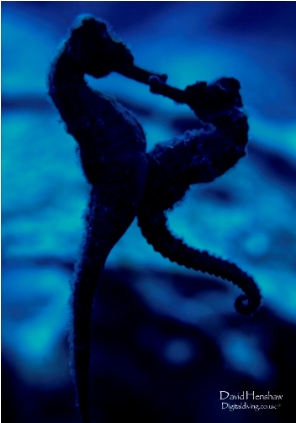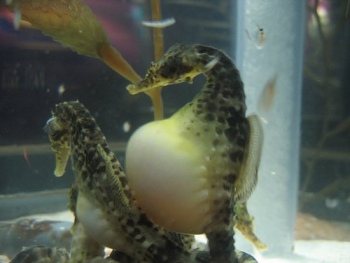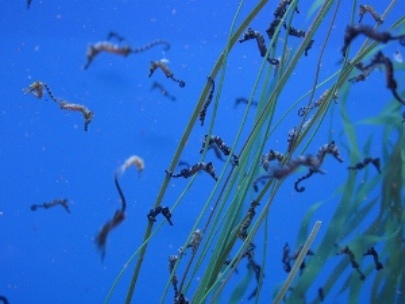Reproduction
Seahorses have quite a unique reproduction cycle. While many would think that the female carries the eggs, like most organisms but the male seahorse actually carries the eggs in brood pouch, which is similar to a kangaroo pouch. Seahorse reproduction usually occurs in from May to August. Seahorses are also considered as being sexual dimorphism, which means the male and female look different. Seahorses are also oviviparous meaning they incubate their eggs inside their bodies. Here are the steps which occur for reproduction.
Courtship
 Before seahorse can even begin
breeding, they must first have a courtship like dance.
Most seahorses will court for a few days. This courtship
assists in the male seahorses ability to receive the
eggs from the female seahorse. Throughout the courtship,
the seahorses will change colors, grab each others
tails, float around, and swim around each other in
unison. The male seahorse will also make clicking noises
with his skull. The female usually tends to become
distracted in which the male will have to regain her
attention usually by snapping at her head. This part of
the courtship is know as the "pre-dawn dance". Once this
is over, the actually dance occurs which can last up to
8 hours. During this dance, the male seahorse will pump
water into it's brood pouch to show the female seahorse
that it is empty and ready to receive the eggs and the
female with stretch out and point her tail down and her
head up towards the surface. Once the females eggs are
mature, the mating pair with grasp on to each other's
tails while slowly floating and spinning to the surface.
During this time, the mating pair will align which will
allow the female seahorse to insert a tube known as an
ovipositer, into the males pouch. The eggs will now
travel through this tube and into the pouch. Once the
eggs are in the pouch, the male will now sink to the
bottom into areas of coverage and fertilize the eggs by
release sperm into the surrounding area, and not
directly in the pouch. The male seahorse now become the
main caretaker of the eggs. After the ritual, the female
leaves and in some cases, the female will return the
following morning and perform some of the beginning
stages of the ritual. The female seahorse may lay
her eggs in other male seahorses until all the eggs have
been laid.
Before seahorse can even begin
breeding, they must first have a courtship like dance.
Most seahorses will court for a few days. This courtship
assists in the male seahorses ability to receive the
eggs from the female seahorse. Throughout the courtship,
the seahorses will change colors, grab each others
tails, float around, and swim around each other in
unison. The male seahorse will also make clicking noises
with his skull. The female usually tends to become
distracted in which the male will have to regain her
attention usually by snapping at her head. This part of
the courtship is know as the "pre-dawn dance". Once this
is over, the actually dance occurs which can last up to
8 hours. During this dance, the male seahorse will pump
water into it's brood pouch to show the female seahorse
that it is empty and ready to receive the eggs and the
female with stretch out and point her tail down and her
head up towards the surface. Once the females eggs are
mature, the mating pair with grasp on to each other's
tails while slowly floating and spinning to the surface.
During this time, the mating pair will align which will
allow the female seahorse to insert a tube known as an
ovipositer, into the males pouch. The eggs will now
travel through this tube and into the pouch. Once the
eggs are in the pouch, the male will now sink to the
bottom into areas of coverage and fertilize the eggs by
release sperm into the surrounding area, and not
directly in the pouch. The male seahorse now become the
main caretaker of the eggs. After the ritual, the female
leaves and in some cases, the female will return the
following morning and perform some of the beginning
stages of the ritual. The female seahorse may lay
her eggs in other male seahorses until all the eggs have
been laid.
Gestation
 Gestation is the carrying of an
embryo or fetus in an organism. This is the time when
the embryos develop inside of the male seahorse's brood
pouch. When the male seahorse fertilized the eggs, they
became embedded in the pouch wall and covered in tissue.
Males seahorse will undergo what a female usually goes
through when pregnant. The males supplies the eggs with
prolactin, which is similar to the hormone that produces
milk in pregnant mammals. The males pouch provides the
essentials needed from the eggs to survive. It provides
the eggs with oxygen as well as acting like an
incubator. Soon the eggs will hatch inside of the pouch,
and the male will slowly increase the salinity of
the pouch to prepare the eggs for the the life in the
sea. The gestation period can last from 40 to 50
days depending on the species and water conditions.
During that time period, the mate will return and
perform parts of the original ritual, and then leave.
Once the eggs have hatched, the male is now ready to
give birth.
Gestation is the carrying of an
embryo or fetus in an organism. This is the time when
the embryos develop inside of the male seahorse's brood
pouch. When the male seahorse fertilized the eggs, they
became embedded in the pouch wall and covered in tissue.
Males seahorse will undergo what a female usually goes
through when pregnant. The males supplies the eggs with
prolactin, which is similar to the hormone that produces
milk in pregnant mammals. The males pouch provides the
essentials needed from the eggs to survive. It provides
the eggs with oxygen as well as acting like an
incubator. Soon the eggs will hatch inside of the pouch,
and the male will slowly increase the salinity of
the pouch to prepare the eggs for the the life in the
sea. The gestation period can last from 40 to 50
days depending on the species and water conditions.
During that time period, the mate will return and
perform parts of the original ritual, and then leave.
Once the eggs have hatched, the male is now ready to
give birth.
Birth
Once the eggs have hatched, the
male seahorse will undergo labor which can last up to a
few hours until the young are ready to emerge. When the
baby seahorses, also known as fry, are ready the male
will push them out with muscular contracts similar to
pregnant mammals such as a
lion. Males
usually give birth at night or in the early morning.
When the babies emerge, they look quite similar to the
adult version but just a much smaller size. Seahorses do
not provide any parental care for their young. Most fry
do not survive to adult due to predators, lack of food,
or other extremes which may explain why they produce so
many young. But due to the gestation period, it
increased the fries survival rate.
birth at night or in the early morning.
When the babies emerge, they look quite similar to the
adult version but just a much smaller size. Seahorses do
not provide any parental care for their young. Most fry
do not survive to adult due to predators, lack of food,
or other extremes which may explain why they produce so
many young. But due to the gestation period, it
increased the fries survival rate.
Continue to Interactions